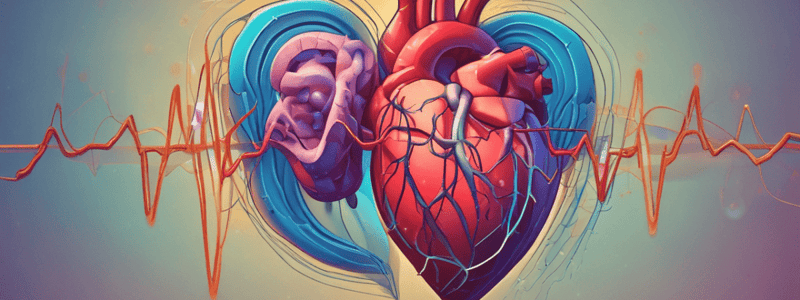Podcast
Questions and Answers
What is the name of the type of atrial tachycardia characterized by 3 or more morphologically different p-waves in the same lead?
What is the name of the type of atrial tachycardia characterized by 3 or more morphologically different p-waves in the same lead?
- Atrial flutter
- Multi-focal atrial tachycardia (correct)
- Ventricular tachycardia
- Atrial fibrillation
What is the main difference between a left bundle branch block (LBBB) and a right bundle branch block (RBBB) on an ECG?
What is the main difference between a left bundle branch block (LBBB) and a right bundle branch block (RBBB) on an ECG?
- The amplitude of the T waves
- The direction of the P waves
- The duration of the PR interval
- The morphology of the QRS complex (correct)
What is the name of the type of ventricular tachycardia characterized by a normal QT interval?
What is the name of the type of ventricular tachycardia characterized by a normal QT interval?
- Polymorphic VT (correct)
- Monomorphic VT
- Ventricular fibrillation
- Ventricular flutter
What is the purpose of administering ABCD drugs in the management of atrial fibrillation?
What is the purpose of administering ABCD drugs in the management of atrial fibrillation?
What is the name of the procedure used as a last resort to shock the heart back into its rhythm?
What is the name of the procedure used as a last resort to shock the heart back into its rhythm?
What is the characteristic ECG pattern seen in atrial flutter?
What is the characteristic ECG pattern seen in atrial flutter?
Which of the following is a characteristic of sinus bradycardia?
Which of the following is a characteristic of sinus bradycardia?
Which of the following is a cause of bradyarrhythmia?
Which of the following is a cause of bradyarrhythmia?
What is the characteristic ECG feature of Mobitz I (Wenckeback) heart block?
What is the characteristic ECG feature of Mobitz I (Wenckeback) heart block?
Which of the following is a type of tachyarrhythmia?
Which of the following is a type of tachyarrhythmia?
What is the characteristic ECG feature of atrial fibrillation?
What is the characteristic ECG feature of atrial fibrillation?
Which of the following is a cause of tachyarrhythmia?
Which of the following is a cause of tachyarrhythmia?
What is the characteristic ECG feature of ventricular fibrillation?
What is the characteristic ECG feature of ventricular fibrillation?
Which of the following is a type of bradyarrhythmia?
Which of the following is a type of bradyarrhythmia?
What is the characteristic ECG feature of focal atrial tachycardia?
What is the characteristic ECG feature of focal atrial tachycardia?
Which of the following is a cause of bradyarrhythmia?
Which of the following is a cause of bradyarrhythmia?
Study Notes
Arrhythmias
- Abnormal electrical activity in the heart
- Abnormality in rate/rhythm/sequence of conduction/origin of conduction
- Normal heart rate: 60-100bpm
Bradyarrhythmias
- Heart rate < 60bpm
- Causes:
- Decreased automaticity
- Increased vagal tone (endurance athletes)
- Inferior wall MI (clot in right coronary artery)
- Drugs that slow down conduction velocity (adenosine, beta blockers, calcium channel blockers, digoxin)
- Slow metabolic activity (hypothyroidism, hypothermia)
- Electrolyte imbalance (hyperkalaemia slows down conduction velocity, K+, Mg2+, and Ca2+ can decrease automaticity)
- High intracranial pressure (Cushing's triad)
- Lyme carditis (bacterial infection that induces bradycardia)
Classification and ECG Changes
- Sinus bradycardia:
- Every p-wave has a QRS
- Slower heart rate but normal PR interval
- AV nodal conduction delays:
- First degree heart block:
- Prolonged PR interval (> 5 small boxes)
- Second degree heart block:
- Mobitz I (Wenckeback):
- Progressive prolongation of PR interval
- Dropped QRS complex
- Mobitz II:
- PR interval is fixed
- Sudden drop of QRS complex
- Mobitz I (Wenckeback):
- Third degree heart block:
- Inconsistent PR interval
- Dropping QRS complex and wide QRS
- Complete dissociation between atria and ventricles
- First degree heart block:
Tachyarrhythmias
- Heart rate > 100bpm
- Types:
- Supraventricular tachycardia (SVT)/atrial tachycardia:
- Sinus tachycardia
- Focal atrial tachycardia (FAT)
- Atrial fibrillation (AF)
- Atrial flutter
- AVNRT (AV nodal re-entrant tachycardia)
- AVRT
- Ventricular tachycardia (VT):
- Monomorphic VT
- Polymorphic VT
- Polymorphic VT with prolonged QT interval (Torsades Depointes)
- Ventricular fibrillation (VF)
- Supraventricular tachycardia (SVT)/atrial tachycardia:
Reasons for Tachyarrhythmias
- Increased automaticity:
- Increased sympathetic tone
- Sympathomimetic drugs
- Increased metabolic activity
- Triggered activity:
- Early after depolarisations (EADs) due to electrolyte imbalance (hypokalaemia)
- Delayed after depolarisation (DADs) due to ischaemia
- Re-entrant circuit:
- AVNRT, AVRT
- Atrial flutter, atrial fibrillation
- Wolff-Parkinson-White syndrome (congenital)
Tachyarrhythmias - ECG Variations
- Narrow QRS (regular rhythm):
- Sinus tachycardia
- FAT
- AVRT, AVNRT
- Atrial flutter
- Narrow QRS (irregular rhythm):
- Atrial fibrillation
- Atrial flutter with variable block
- MAT
- Wide QRS (regular rhythm):
- VT (monomorphic)
- Bundle branch blocks
- Wide QRS (irregular rhythm):
- VT (polymorphic)
- VF
ECG Changes in Hyper and Hypokalaemia
- Hyperkalaemia:
- Peaked T waves
- Widened QRS
- Prolonged PR interval
- Hypokalaemia:
- Flat T waves
- Prolonged QT interval
- U waves
Studying That Suits You
Use AI to generate personalized quizzes and flashcards to suit your learning preferences.
Related Documents
Description
Learn about abnormal heart rhythms, including bradyarrhythmias, and their causes, such as decreased automaticity and inferior wall MI.



